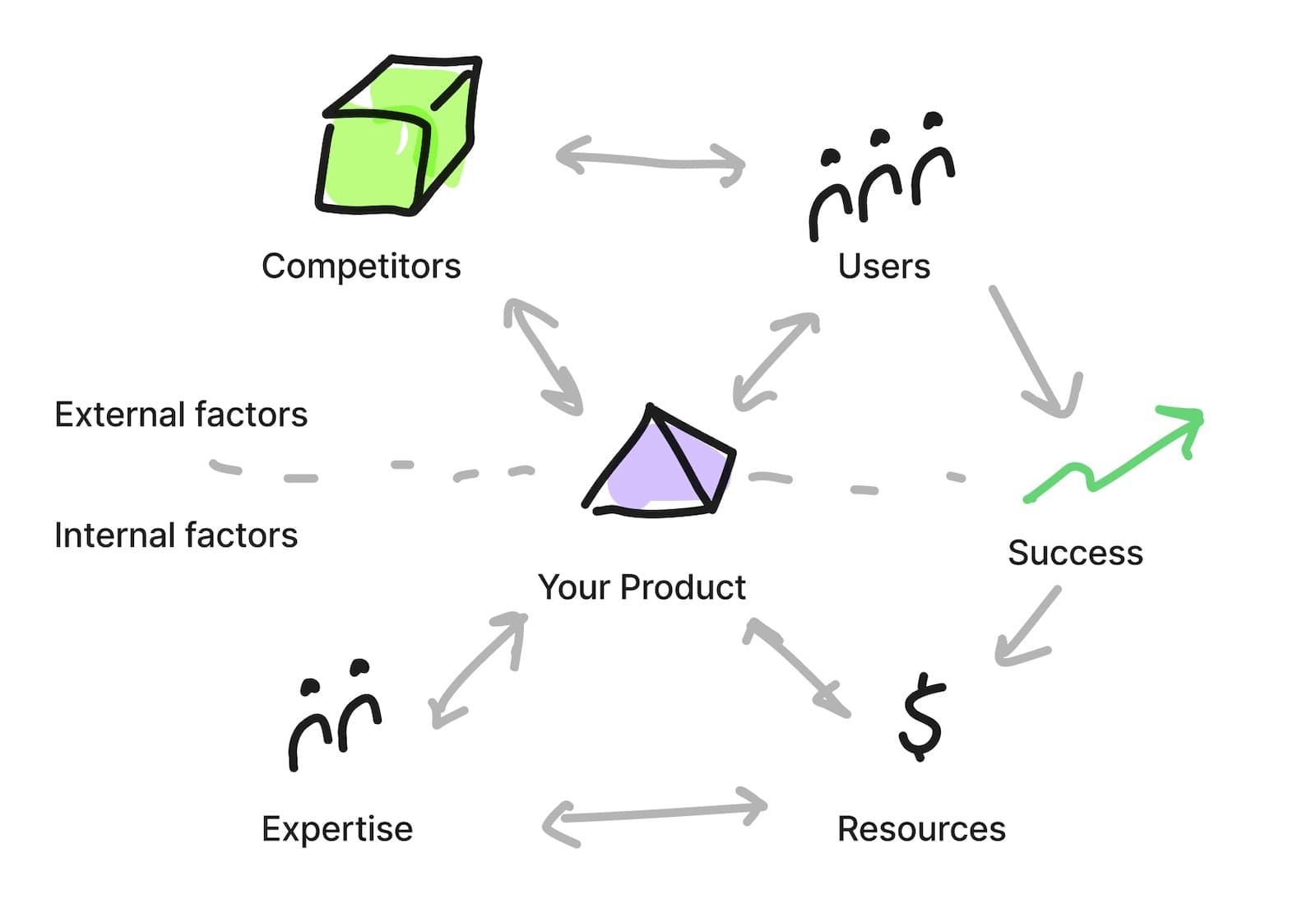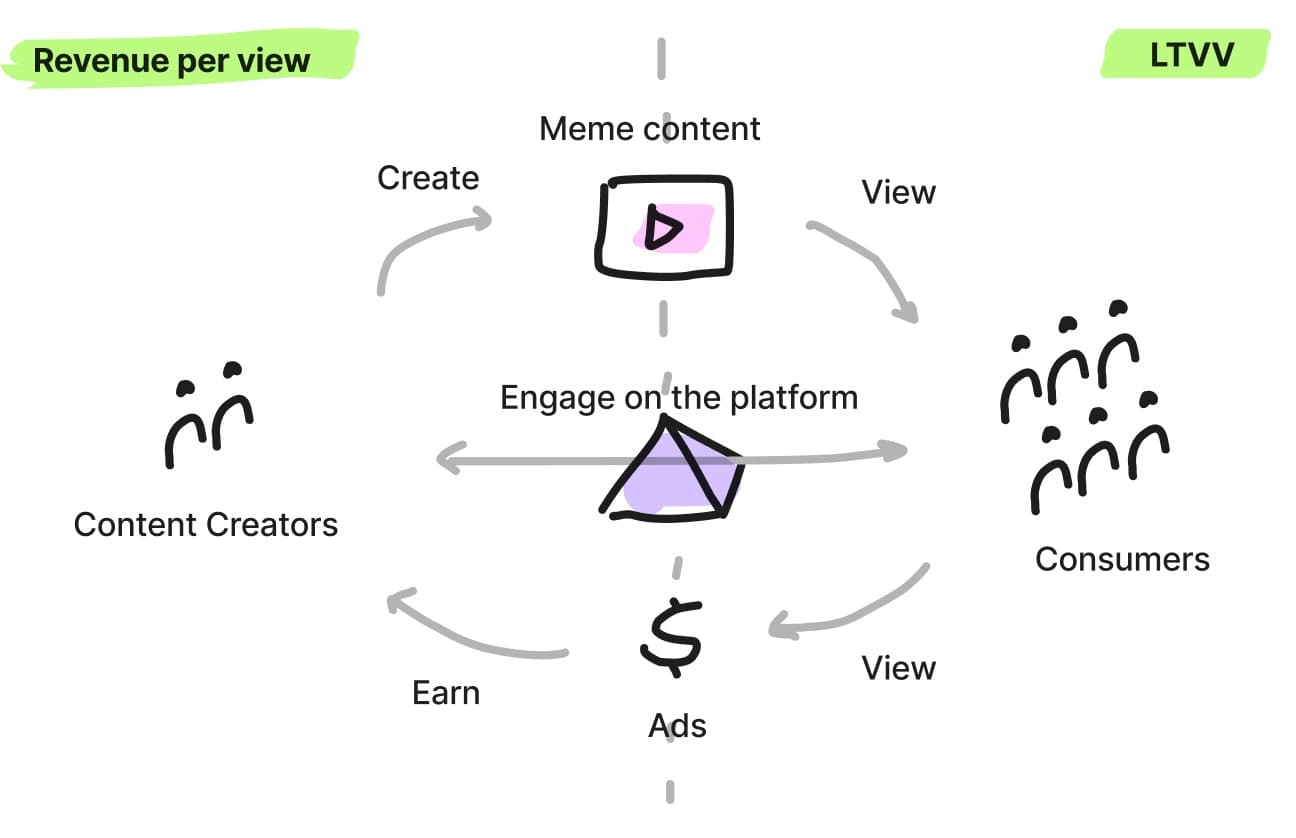How - Keep Focus in the Right Things
Turning Purpose into Practice
From Purpose to a Plan of Building Your Product
For building a product, you need more than an idea and a purpose. A plan, in the form of a sound product strategy, to take your product's purpose to practice. Your product strategy should answer at least the following questions: Why should your customers care about your product? Who are those customers? How does your product fill the gaps in the market? How will you measure success? What do you need to build and do you have the expertise and resources you need in order to build that? How do you validate what you are building is taking you towards the desired outcomes and towards success?

For delivering a product you need the right expertise and resources aligned against your product's purpose and vision, a plan how the purpose manifests itself as a product. While a product's purpose is to be a Home for video meme creators, in practice it means providing video meme creators a place to share their content for consumers to watch in multiple devices and platforms, ways to engage with their community, and a system to earn from their content, in a way that suits their content type and style.
Building a Home for Video Meme Creators
Short-form video content creators, still to date, are struggling with monetising their content through the platforms they distribute their content on. Platforms themselves are monetising from the content, while content creators often aren't fully part of the equation. Through the founders passion in the scene and from the existing video distribution platforms we identified a specific niche, video meme creators, which were generating a lot of views, but getting very little monetary compensation on those views, because of how the platforms' revenue models were designed.
Defining North Star Metrics to Drive the Practical Work
The structure of building a Home for video meme creators was reduced to two main goals; different sides of the platform were turned into operational goals: time and amount of videos users consume and engage with on the platform, and the amount of ads watched resulting in revenue for the creators. It is evident that the more videos are consumed, the more ads can be shown, but pushing too many ads to users will adversely affect the video consumption - and furthermore retention and revenue. The magic formula balancing these two came from understanding the levels of revenue we needed to generate for the creators to be a viable option for the existing platforms.
North Star metric on the consumer side became the content consumption, lifetime view value or LTVV as a metric for consumer satisfaction and retention. Revenue per views became a North Star metric for the content creators side - a metric familiar from other platforms, guiding our targets.
As a counter measure we used a concept failed session - if a user didn't watch at least one video on the platform during the session, it would be considered as failed session - as we couldn't deliver the main value proposition for the consumer; viewing video memes. Hence a user only watching an ad during a session, while good for the revenue in the short term, would be considered as a failure to deliver value to the consumer. These all together provided our product development goals and guardrails to reflect the work against.

While we couldn't immediately match the virality and views provided by the incumbent platforms, we were able to create a home for their content and core fans and generate 2-3x the revenue they were making on the incumbent platforms - if they were making any at all to start with.
The Right Expertise and Investing in Technology That Matters
Our advantage over the incumbent platforms was the focus we put into understanding the intricacies of the content type and serving those specific needs, like showcasing video meme trends. Our team was equipped with the most influential content creators and people focused on managing relations with them as well as providing us the needed growth in our creator network.
From technology point-of-view we were geared towards optimising the video delivery costs for that specific content type, for advertising we focused on the mechanics. Further revenue optimisations would only follow should the mechanics work. For everything else we leaned towards standard industry solutions and other functions were managed as someone else's side job when needed. Processes, technology and people were all aligned with the product strategy, resulting in a team that was nimble, moved fast and had just the necessary skills to build just the product needed.
Scarcity Is the Best Driver for Prioritisation
Working at startups has been very educational on what scarcity means. You have a finite budget that you are burning at a certain rate, depending on your team size and the bills you pay to keep your product operational. You work against time to either make your service and product pay for the burn rate and the bills, or convince an investor to provide you with more budget, allowing for additional time to make your product pay the bills. Once the budget runs out, you are out of business.
Scarcity forces rapid iterations with an aim to make as much impact as possible. Whatever the context you work in, bring as much visibility into the operational costs and revenue streams as possible, to make the scarcity feel tangible. Working without any resource boundaries is almost a certain recipe to spending time on lengthy feature projects without tangible outcomes.
Scarcity can be simulated with wise time-boxing. In my experience, a recommended time box or cycle time for building features is an industry standard of 2 weeks, which gives ample time for building meaningful things without too much overhead on changing context. During those two weeks of focused delivery time, do the required product work to find what to deliver next. Respect the time boxes. If scope starts to creep, assess what is the desired outcome and what shortcuts can be taken to reach those outcomes. If more effort is required, consider carefully and make a conscious decision, whether the added cost for pro-longing the work is justified.
Bundle the two week periods into three or four 6-8 week cycles, which are focused on specific goals, using for example Objectives and Key Results (OKRs) to walk the path how your expected impact on delivery will link to your North Star or product vision. Between these longer cycles, also assess your products most essential focal points and whether you are equipped to build the solutions with your existing expertise, structure and resources.
Key Takeaways
Start with outcomes and focus relentlessly on the value you aim to deliver. Align your users' success to your product's success. When your product enters the market, competitors are likely to react and hence the market is constantly evolving. Make sure you have the expertise and resources to constantly deliver value unattainable with the competitors' products. Define routine product creation cycles that give you points in time to assess your direction, and are long enough for delivering outcomes.
Inspiration and Further Reading:
- The North Star Playbook: The guide to discovering your product's North Star by Amplitude
- The Star Model™ by Jay R. Galbraith
- Radical Focus: Achieving Your Most Important Goals with Objectives and Key Results by Christina R. Wodtke
- Shape Up: Stop Running in Circles and Ship Work that Matters by Ryan Singer